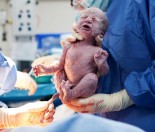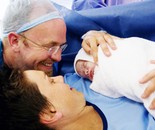Episiotomies and tears are common after childbirth. This article explains episiotomies and different types of perineal tears and how they are repaired.
Approximately 77% of women in New Zealand give birth to their babies vaginally, either by a normal delivery, forcep delivery or by ventouse. The vagina and perineum are designed to gradually stretch during childbirth, to allow the passage of the baby’s head and body, and many women are lucky enough to walk away with a mere graze of two! This is known as an ‘intact perineum’. However, many women will need stitches after the birth, either from having had a tear to the skin and muscle of the vagina and perineum or from having an episiotomy.
What is the perineum?
The perineum is a group of muscles between the vagina and the anus/rectum. There are superficial and deep muscles and they form part of the pelvic floor, which is a hammock shaped group of muscles, which have several functions:
- Support of abdominal organs
- Sexual intercourse
- Childbirth
- Continence of urine and faeces
When making a decision whether to suture or not to suture, the functions of the perineum have to be taken into account. No one wants sutures after childbirth, but these functions of the pelvic floor are vital to women’s health and need to be maintained after childbirth.
What is an episiotomy?
An episiotomy is a surgical cut that is performed during childbirth to enlarge the vaginal opening. It is performed by the midwife or doctor who is delivering your baby for one of the following reasons:
- To enlarge the vaginal opening to enable the use of forceps to help deliver the baby
- To speed up the birth if the baby is distressed
- In premature birth to protect the baby’s head from undue pressure
- To enlarge the vaginal opening if the perineum is not stretching during the birth.
Episiotomies are a lot less common than they were 10-20 years ago. In New Zealand a ‘mediolateral’ (meaning middle/side) episiotomy is usually used, where the cut is made at an angle to reduce the risk of it extending towards the anus as the head is born.
An episiotomy will always require sutures.
| Find the Right Pregnancy & Birth Book for You!
Click here for the Most Popular International BestSellers |
||||
 |
 |
 |
||
Different types of perineal tears
Many women, particularly first time mums, experience a tear during childbirth. There are different types of tears and usually these will be assessed and repaired by the midwife or doctor who looked after you during the birth.
First degree tears are tears to the skin only. These are therefore superficial and rarely require sutures. The exception to this would be if the skin was poorly aligned and could heal badly or if it was bleeding.
Second degree tears involve the skin and the muscle of the vagina and perineum. The tear may be deep, requiring layers of sutures, or superficial, requiring minimal sutures.
Third degree tears are rare but more serious as they involve not only the skin and muscle of the perineum, but have also extended towards the anus. The anal sphincter is made up of an external and internal sphincter –which are bands of muscle. Varying severities of third degree tears may occur from a small tear to the external sphincter to a more severe tear involving the internal and external sphincter.
Fourth degree tears are very rare. They involve damage to the anal epithelium which is the covering of the anal canal.
How are they repaired?
First and second degree tears are repaired using either an epidural if the mother already has one, or local anaesthetic, which is injected prior to the stitches being inserted. This local anaesthetic will take away the sensation of pain, but not touch.
Your midwife or doctor will usually put your legs into stirrups (lithotomy), which is undignified, but not uncomfortable. Alternatively, they may ask you to part your legs and relax them on the bed.
The vagina is repaired first, then the perineum is repaired, starting with the deepest muscles and finishing with the skin. Most people now use a ‘sub-cuticular’ stitch to the skin, which means there are no knots on the outside. This is far more comfortable than the old fashioned line of knots that women had after childbirth.
A third degree tear is more serious and will always be repaired in an operating theatre. It is vital that the torn sphincter is repaired correctly, with minimal risk of infection. An epidural or spinal anaesthetic will be given to ensure that the anal sphincter muscles are completely relaxed, to enable a good repair.
Who will do my stitches?
The midwife or doctor who cared for you while you gave birth will usually do your stitches too. If they are inexperienced they may ask a colleague to do the repair, or to supervise them while they do it themselves.
A third or fourth degree tear will always be repaired by an experienced obstetrician.
Will I need to have my stitches removed?
As the suture material is dissolvable there is usually no need to have sutures removed. They dissolve and fall out over the few weeks following the birth.
What are the risks associated with tears and episiotomies?
- Infection – help to prevent this by cleaning the wound frequently with luke warm water.
- Increased blood loss
- Poor healing, especially if taking a poor diet or not resting enough!
- Pain – ensure you take sufficient pain relief
- Third and fourth degree tears are especially associated with risks of infection and impaired continence. Some women experience reduced control over passing wind, or may be incontinent of liquid or solid stools.
- After third and fourth degree tears there is an increased risk of repeat tears or worsened symptoms during subsequent births – elective Caesarean section will often be discussed as an option for these women.
Useful articles
See our article on Tips for Healthy Perineums
For more information on what to expect during a Normal birth, click here.
Approximately 10% of women in New Zealand have a ventouse or forcep delivery. Assisted Birth provides a wealth of information on what to expect.







I am a nurse working in theatre. I have seen a lot of 3rd degree tear being repaired in our theatres (from the delivery suite). My husband and I are planning to have another baby (2nd), but im too scared about the whole vaginal delivery because of what I have seen here. My OB back in my home country performed an episiotomy when I had my first child 11 years ago. Can I possibly request for an episiotomy just to prevent the tear on my next delivery?
Hi Danielle Research is pretty black and white, that performing routine episiotomies in general causes more ongoing perineal trauma than repairing natural tears, and they don’t absolutely prevent a 3rd degree tear. There is a time and place for an episiotomy – personally as an LMC midwife I’d need to do one about once a year perhaps. Sadly your theatre nurse experience, has left you with a tainted view, because it means you haven’t been exposed to the massive majority of women who have no tear or a small tear requiring a little suturing that heals beautifully in a few… Read more »